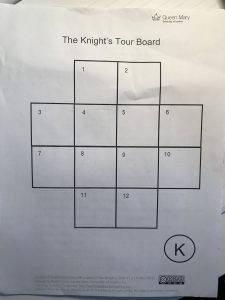Coding without computers is not a workshop I thought I would be attending in an EdTech course, but once I got there I realized that coding without computers is more relevant and accessible to EdTech as any coding workshop. Carrie Antoniazzi came from Science World to discuss coding without computers to us. What Carrie focused on was the process of Computational Thinking. Computational thinking is the process of: logical reasoning, decomposition, evaluation, abstraction, patterns and generalizations, and algorithmic thinking. Now these are all processes that computers use when coding, but they are also processes that can be taught and applied in the classroom without the use of technology.
Carrie provided us with activities that made us use our computational thinking without us even realizing it. One of these activities was coding your friend where students created a task for a classmate to do using simple commands such as arrows and other symbols. Students then had to follow this exact code in order to carry out the task. Some people had more success than others, but the main thing realized in this activity was how every aspect of computational thinking was used in order to have your friend carry out the task as a computer would.

Coding your own friend. The legend is important for students to understand what each symbol means, just as a computer would use symbols to carry out a task.
Another activity Carrie had us do was called the Knight’s Tour Board. The idea behind this activity was that your knight would start in square 1 and had to end in square 1. The knight has to stop on every square on the board exactly one time before ending back at 1. The knight can only move in an L pattern. Students must keep track of their moves on a separate piece of paper in order to keep track of the different ways they have succeeded, as well as to help with assessment.

The Knight’s Tour Board.
This simple puzzle was extremely effective in forcing us to use our computational thinking skills. This would also be a great activity for students in the intermediate grades and would also work as a great brain buster or something for students to do when they finish early.
The opportunities and activities to encourage students to use their computational thinking skills are endless. It is important that we keep an open mind when planning lessons surrounding technology, as often the most effective activities don’t even require a computer.
“Using our computational thinking skills without even realizing it” – I love this thought from your blog! These were such great activities Carrie had us do. Coding no longer has to be daunting and tedious, you can make activities to teach coding basics with minimal supplies and no computer! This is also great for schools who don’t have a large budget for technology. I love that we can make coding accessible to all!
I like your idea of using the Knight’s Tour activity as an extension or a “brain buster” as you put it. If it doesn’t fit into what the class is doing at the time for ADST, those are great ways to fit it in and get students working on their computational thinking. It’s also just a fun activity.